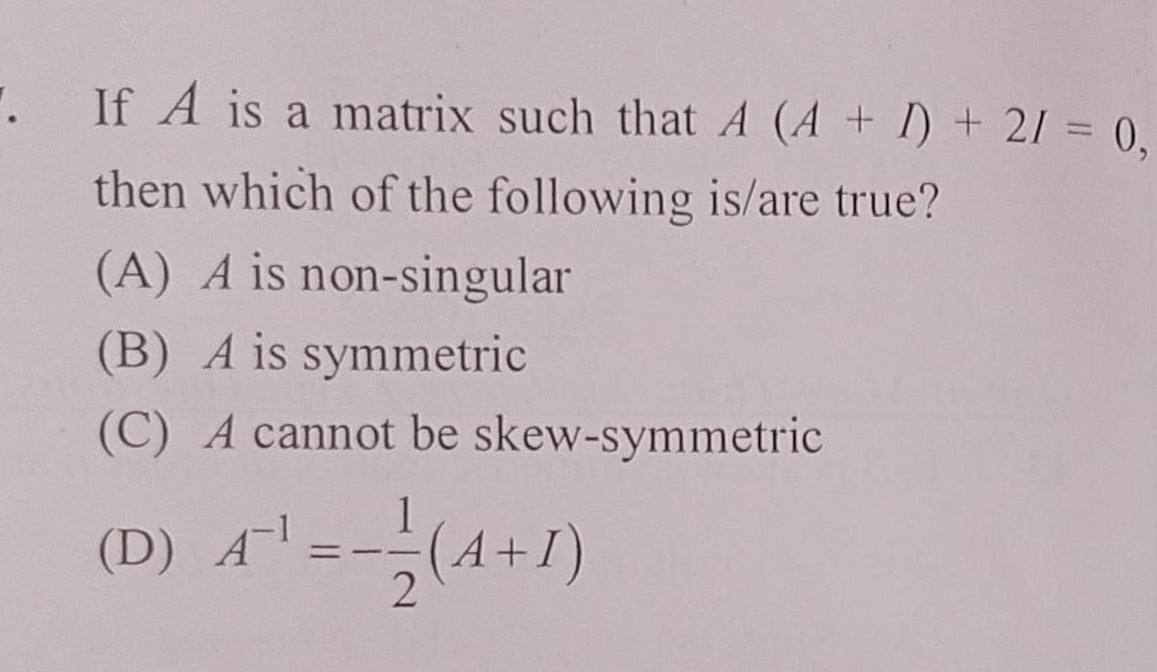Question
Question: If $A$ is a matrix such that $A(A + I) + 2I = 0$, then which of the following is/are true?...
If A is a matrix such that A(A+I)+2I=0, then which of the following is/are true?

A is non-singular
A is symmetric
A cannot be skew-symmetric
A−1=−21(A+I)
(A), (C), (D)
Solution
The given matrix equation is A(A+I)+2I=0. Expanding this, we get A2+AI+2I=0, which simplifies to A2+A+2I=0.
Let's analyze each option:
(A) A is non-singular
From the equation A2+A+2I=0, we can write A(A+I)=−2I. Taking the determinant of both sides:
det(A(A+I))=det(−2I)
det(A)det(A+I)=det(−2I)
If A is an n×n matrix, then det(−2I)=(−2)ndet(I)=(−2)n⋅1=(−2)n.
Since (−2)n=0 for any integer n, it implies that det(A)det(A+I)=0.
Therefore, det(A)=0, which means A is non-singular. This statement is true.
(B) A is symmetric
A matrix A is symmetric if AT=A.
The matrix A satisfies the polynomial equation x2+x+2=0. The eigenvalues of A are the roots of this characteristic equation.
The roots are x=2−1±12−4(1)(2)=2−1±1−8=2−1±−7=2−1±i7.
These are complex eigenvalues.
If A is a real symmetric matrix, its eigenvalues must be real. Since the eigenvalues are complex, A cannot be a real symmetric matrix. In the context of JEE/NEET, matrices are generally assumed to be real unless specified otherwise.
Even if A is a complex matrix, the statement "A is symmetric" implies it is a necessary property. However, one can construct non-symmetric complex matrices that satisfy this equation. Therefore, this statement is not universally true for any matrix A satisfying the condition. This statement is false.
(C) A cannot be skew-symmetric
A matrix A is skew-symmetric if AT=−A.
Assume, for contradiction, that A is skew-symmetric.
We are given A2+A+2I=0.
Taking the transpose of the entire equation:
(A2+A+2I)T=0T
(A2)T+AT+(2I)T=0
(AT)2+AT+2I=0
Since we assumed AT=−A, substitute this into the equation:
(−A)2+(−A)+2I=0
A2−A+2I=0 (Equation 1)
We also have the original equation:
A2+A+2I=0 (Equation 2)
Subtract Equation 1 from Equation 2:
(A2+A+2I)−(A2−A+2I)=0−0
A2+A+2I−A2+A−2I=0
2A=0
A=0
Now, substitute A=0 back into the original equation A2+A+2I=0:
02+0+2I=0
2I=0
This implies that the identity matrix I is a zero matrix, which is false for any identity matrix of order n≥1.
Therefore, our initial assumption that A is skew-symmetric must be false. Hence, A cannot be skew-symmetric. This logic holds for both real and complex matrices. This statement is true.
(D) A−1=−21(A+I)
From the given equation A2+A+2I=0.
Since A is non-singular (as established in option A), A−1 exists.
Multiply the entire equation by A−1 from the left (or right):
A−1(A2+A+2I)=A−1O
A−1A2+A−1A+A−1(2I)=O
(A−1A)A+I+2A−1I=O
IA+I+2A−1=O
A+I+2A−1=O
2A−1=−(A+I)
A−1=−21(A+I)
This statement is true.
Therefore, the true statements are (A), (C), and (D).
